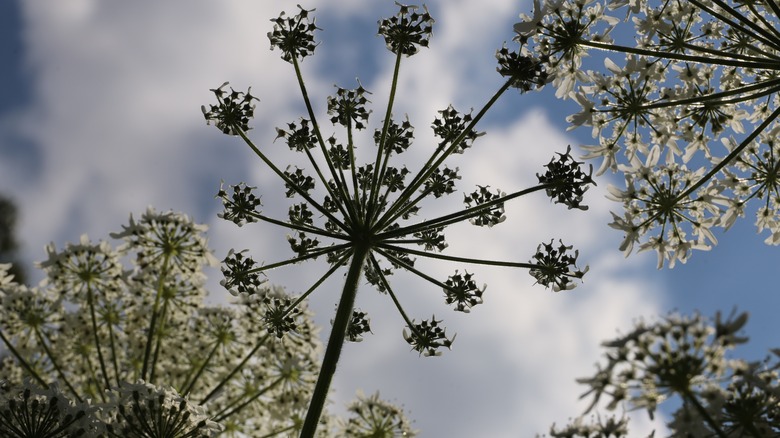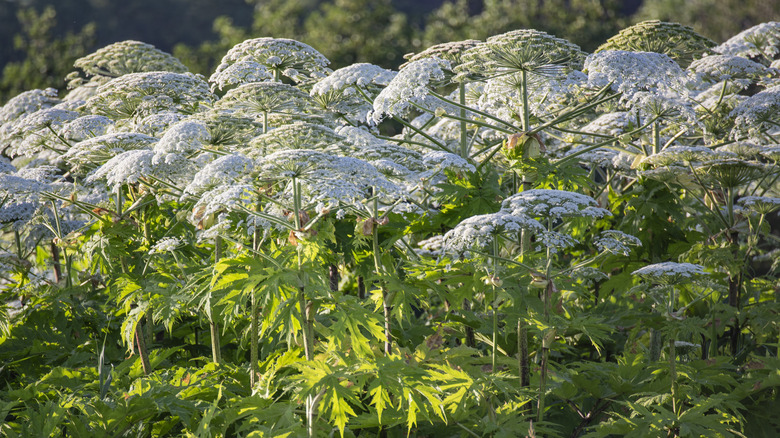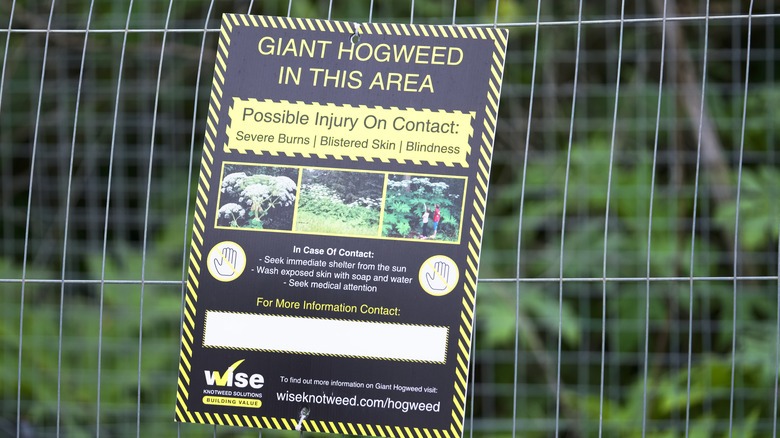Why You Need To Keep An Eye Out For This Dangerous Weed In Your Yard
Weeds are a common problem for any gardener. The plants people consider weeds often look unattractive, and outcompete with the flora you may actually want in your yard. While there are certain weeds you shouldn't pull from your garden, some others should be removed as soon as they start to grow to prevent them from establishing themselves in your garden.
The weeds you should be cautious of are the ones posing a danger to you and your family. Such is the case with a plant known as giant hogweed, or Heracleum mantegazzianum. It is related to carrots and parsley, but it's not as harmless as these delicious foods. Just a touch from giant hogweed may cause severe burns and rashes. In the United States, it is also considered an invasive plant and has spread to many states on the east and west coasts of the country. It's not the only plant that people might not know is deadly or dangerous in the United States, but it's one that poses a serious risk all the same.
Once it starts growing, removing giant hogweed isn't easy. One plant can produce around 20,000 seeds and makes itself at home in many habitats including ditches, pastures, and alongside rivers and streams. This is why it's so important to remove the hogweed as soon as you find signs of it around your home.
What is giant hogweed and why is it so dangerous?
True to its name, giant hogweed is a very large plant. It can grow over 14 feet tall, and its flower heads can be nearly 2.5 feet in diameter. At this height, it's pretty easy to tell it apart from other similar-looking plants. However, while it's still growing, it may be confused with species such as cow parsnip, wild parsnip, poison hemlock, and water hemlock. Not that it matters much if you get them confused as all of these plants are equally as dangerous and should also be removed right away if you see them in your yard.
Giant hogweed poses a danger to anyone who gets too close to it. The plant contains toxic sap. Interestingly, it's not the sap itself that poses the most danger, but the mix of the secretion and sunlight. There are chemicals in giant hogweed, known as furanocoumarins, which cause skin inflammation and burns when exposed to sunlight. It only takes about 15 minutes for blisters to form. While these scars usually last a few months, there have been cases of the injury causing pain and scarring for up to six years.
Not only are these plants dangerous to you, they are invasive. Giant hogweed tends to grow in thick clumps, killing many nearby plants. It is most often found in the Pacific Northwest and the Northeastern states, such as Maine, New York, Oregon, Connecticut, Illinois, Massachusetts, Pennsylvania, Washington, and Vermont.
How to remove giant hogweed
Because of the danger these plants pose, many places around the United States will handle the removal. Companies and government agencies come out and cut the roots and do a yearly checkup until there's evidence that the plants are truly gone to ensure the plant doesn't spread. Seeds can stay viable in the soil for up to 10 years without growing, so it sometimes takes quite a bit of time to truly eliminate all traces of giant hogweed. Because of how easily it propagates, it's not easy to remove, even with weed-killing hacks like the game-changing sugar hack that kills weeds. While it may kill the main plant, it may not work fast enough to stop the seeds from spreading.
If you find a weed that you believe is giant hogweed, it's a good idea to call local weed control specialists, environmental agencies, or plant-focused agencies near you. It may help to take pictures of the stem, flowers, and leaves, as long as you can do so from a safe distance and without touching the plants, so they can identify the plant for you and confirm whether or not it's giant hogweed.
If you don't have a local company to help you remove the weed, you can do it on your own as long as you take care. The most important thing is to cover up and wipe down all of your tools and clothing after you're done.


